|
|
|
Sort Order |
|
|
|
Items / Page
|
|
|
|
|
|
|
| Srl | Item |
| 1 |
ID:
138828


|
|
|
|
|
| Summary/Abstract |
Modern communication technology is emerging rapidly, with tremendous social implications. The key innovations introduced by this technology include the increased pervasiveness and the rich nature of digitally transmitted information, and a new type of network structure over which it is disseminated. The articles in this special issue present theoretical and empirical research on the relationship between communication technology and political conflict and violence. There are different pathways through which this can happen: technology can facilitate collective action, but at the same time give governments the opportunity to censor content and gather intelligence about dissidents. Also, audience effects can be introduced by the rich and instant transmission of information from conflict regions. The contributions to this special issue can be divided into three groups. A first group of articles looks at the effects of ‘old’ communication technologies with state-of-the-art methods, which is necessary to see if the effects of modern technology really differ. A second category of articles focuses on ‘new’ communication technologies, and try to assess their effect on conflict both theoretically and empirically. The third and last category reverses this question, and looks at the reflection of war and violence in (traditional and new) media channels.
|
|
|
|
|
|
|
|
|
|
|
|
|
|
|
|
| 2 |
ID:
090992


|
|
|
|
|
| Publication |
2009.
|
| Summary/Abstract |
The literature suggests that geographically concentrated groups face a higher likelihood of conflict. While this finding seems to be commonly accepted, there is no clear consensus that explains why this is the case. Two competing mechanisms have been proposed: first, a motivation-driven mechanism, where the existence of a well-defined group territory makes the group more likely to fight for it; and second, an opportunity-driven link, where concentration facilitates group coordination for collective action. This article aims to resolve this controversy by developing new settlement pattern indicators based on Geographic Information Systems (GIS) data. Using conflict data at the level of ethnic groups, I show that there is clear evidence in favor of the opportunity mechanism. Thus, the effect of group concentration on conflict seems to be driven by the strategic advantages for group coordination that the spatial proximity of group members provides.
The literature suggests that geographically concentrated groups face a higher likelihood of conflict. While this finding seems to be commonly accepted, there is no clear consensus that explains why this is the case. Two competing mechanisms have been
|
|
|
|
|
|
|
|
|
|
|
|
|
|
|
|
| 3 |
ID:
126807
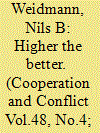

|
|
|
|
|
| Publication |
2013.
|
| Summary/Abstract |
The majority of conflict event datasets rely on media reports as their sole source of information. Because of the various difficulties associated with media reports, it is useful to compare conflict events based on them with those obtained from other observers. A paper published in 2010 by O'Loughlin and colleagues makes a first attempt to do this by using (1) a media-based event dataset and (2) military records on Afghanistan. While the authors conclude that the level of agreement between the two datasets is high, my results show that this goes away once we aggregate to finer analytical resolutions - those that are typically used in micro-level conflict analyses. Thus, rather than giving us the 'all-clear' for the accuracy and quality of media-based conflict data, my results once again point to the importance of robustness tests in quantitative conflict research, but also to the need to study the discrepancies in different reporting mechanisms to find out what they can and what they cannot tell us.
|
|
|
|
|
|
|
|
|
|
|
|
|
|
|
|
| 4 |
ID:
110540


|
|
|
|
|
| Publication |
2011.
|
| Summary/Abstract |
Contemporary research on civil war has largely dismissed the role of political and economic grievances, focusing instead on opportunities for conflict. However, these strong claims rest on questionable theoretical and empirical grounds. Whereas scholars have examined primarily the relationship between individual inequality and conflict, we argue that horizontal inequalities between politically relevant ethnic groups and states at large can promote ethnonationalist conflict. Extending the empirical scope to the entire world, this article introduces a new spatial method that combines our newly geocoded data on ethnic groups' settlement areas with spatial wealth estimates. Based on these methodological advances, we find that, in highly unequal societies, both rich and poor groups fight more often than those groups whose wealth lies closer to the country average. Our results remain robust to a number of alternative sample definitions and specifications.
|
|
|
|
|
|
|
|
|
|
|
|
|
|
|
|
| 5 |
ID:
119717


|
|
|
|
|
| Publication |
2013.
|
| Summary/Abstract |
Local communities such as villages are commonly assumed to be vital partners in counterinsurgency and post-conflict reconstruction. However, the success of all policies based on this assumption depends on the level of social cohesion at the community level: communities with internal cleavages and fissures will be less effective in making external efforts a success. In this article, we study how exposure to violence during civil war affects the internal cohesion of a community. On the one hand, we could assume that exposure to a common threat strengthens social ties. On the other hand, shifting power structures in conflict regions could introduce new loyalties and cleavages at the village level, thus eroding a community's social glue. We use data from a survey conducted in northern Afghanistan and combine it with the data on violent events from military records. Our results provide evidence for the second mechanism: exposure to violence causes villagers to diverge in their support for conflicting parties. We estimate a spatial-temporal gravity model, where spatially and temporally proximate events have the highest impact on this divergence at the village level.
|
|
|
|
|
|
|
|
|
|
|
|
|
|
|
|
| 6 |
ID:
139796
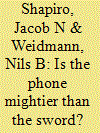

|
|
|
|
|
| Summary/Abstract |
Does improved communication provided by modern cellphone technology affect the rise or fall of violence during insurgencies? A priori predictions are ambiguous; introducing cellphones can enhance insurgent communications but can also make it easier for the population to share information with counterinsurgents and creates opportunities for signals intelligence collection. We provide the first systematic micro-level test of the effect of cellphone communication on conflict using data on Iraq's cellphone network (2004–2009) and event data on violence. We show that increased mobile communications reduced insurgent violence in Iraq, both at the district level and for specific local coverage areas. The results provide support for models of insurgency that focus on noncombatants providing information as the key constraint on violent groups and highlight the fact that small changes in the transaction costs of cooperating with the government can have large macro effects on conflict.
|
|
|
|
|
|
|
|
|
|
|
|
|
|
|
|
| 7 |
ID:
137034
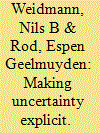

|
|
|
|
|
| Summary/Abstract |
When coding events from media sources – as the majority of data projects do – different reports may oftentimes contain contradictory information. What do coders make of this? It is up to them to aggregate different reports into one coded event, and to supplement missing information based on other sources or their own background information. If not addressed properly, this may lead to a lack of replicability and to low reliability of the final data product. In this short article, we present an approach for separating (i) event reports and the information contained in them, and (ii) events, which are based on aggregate information from the reports and constitute the final data product. Our procedure preserves uncertainty arising from multiple reports and gives the user control over how missing and conflicting information should be dealt with. We illustrate our procedure with data from a current coding project, the Mass Mobilization in Autocracies Database (MMAD).
|
|
|
|
|
|
|
|
|
|
|
|
|
|
|
|
| 8 |
ID:
141193
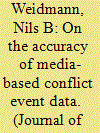

|
|
|
|
|
| Summary/Abstract |
Empirical researchers of civil war rarely collect data on violence themselves and instead rely on other sources of information. One frequently used source is media reports, which serve as the basis for many ongoing data projects in the discipline. However, news reports rarely cover a conflict comprehensively and objectively and may therefore be prone to various reporting issues. This article provides an analysis of the accuracy of information given in news reports. In particular, if focuses on two types of “hard facts” that event data sets require: the location of an event and its severity. By linking media reports to firsthand accounts from a military database, the article does two things: (1) it analyzes the determinants of inaccuracy and confirms the expectation that events with a low number of observers tend to have higher reporting inaccuracies and (2) it assesses the magnitude of these inaccuracies and the implications for conducting empirical analyses with media-based event data.
|
|
|
|
|
|
|
|
|
|
|
|
|
|
|
|
| 9 |
ID:
101683
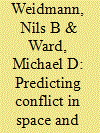

|
|
|
|
|
| Publication |
2010.
|
| Summary/Abstract |
The prediction of conflict constitutes a challenge to social scientists. This article explores whether the incorporation of geography can help us make our forecasts of political violence more accurate. The authors describe a spatially and temporally autoregressive discrete regression model, following the framework of Geyer and Thompson. This model is applied to geo-located data on attributes and conflict events in Bosnia over the period from March 1992 to October 1995. Results show that there is a strong spatial as well as temporal dimension to the outbreak of violence in Bosnia. The authors then explore the use of this model for predicting future conflict. Using a simulation approach, the predictive accuracy of the spatial-temporal model is compared to a standard regression model that only includes time lags. The results show that even in a difficult out-of-sample prediction task, the incorporation of space improves our forecasts of future conflict.
|
|
|
|
|
|
|
|
|
|
|
|
|
|
|
|
| 10 |
ID:
149110


|
|
|
|
|
| Summary/Abstract |
What is the main motivation for replication in international relations? How can we implement it, and who is in charge? With a variety of proposals put forward by the contributors to this special issue, it seems useful to provide a synopsis. This article does so by asking a set of key questions related to replication, and by summarizing the stance each proposal takes with respect to these questions. This comparison reveals that there are fewer disagreements than we would think: there is broad consensus when it comes to the motivation and the need for replication in our field. However, proposals diverge as to how replication should be best implemented and, to a lesser extent, who should be the driving force behind this. This article concludes with a recommendation for a dual strategy. First, simple replication on the journal side should be implemented as a routine quality check to weed out work that does not even satisfy basic replication standards. Second, journals should be encouraged to allow publication of more comprehensive, in-depth replication studies with an independent contribution.
|
|
|
|
|
|
|
|
|
|
|
|
|
|
|
|
| 11 |
ID:
098417


|
|
|
|
|
| Publication |
2010.
|
| Summary/Abstract |
Whether qualitative or quantitative, contemporary civil-war studies have a tendency to over-aggregate empirical evidence. In order to open the black box of the state, it is necessary to pinpoint the location of key conflict parties. As a contribution to this task, this article describes a data project that geo-references ethnic groups around the world. Relying on maps and data drawn from the classical Soviet Atlas Narodov Mira (ANM), the 'Geo-referencing of ethnic groups' (GREG) dataset employs geographic information systems (GIS) to represent group territories as polygons. This article introduces the structure of the GREG dataset and gives an example for its application by examining the impact of group concentration on conflict. In line with previous findings, the authors show that groups with a single territorial cluster according to GREG have a significantly higher risk of conflict. This example demonstrates how the GREG dataset can be processed in the R statistical package without specific skills in GIS. The authors also provide a detailed discussion of the shortcomings of the GREG dataset, resulting from the datedness of the ANM and its unclear coding conventions. In comparing GREG to other datasets on ethnicity, the article makes an attempt to illustrate the strengths and weaknesses associated with the GREG database.
|
|
|
|
|
|
|
|
|
|
|
|
|
|
|
|
| 12 |
ID:
101617
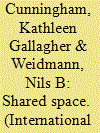

|
|
|
|
|
| Publication |
2010.
|
| Summary/Abstract |
Why does ethnic violence occur in some places but not others? This paper argues that the local ethnic configuration below the national level is an important determinant of how likely conflict is in any particular place. Existing studies of ethnicity and conflict focus on national-level fractionalization or dominance, but much of the politics surrounding ethnic groups' grievances and disputes takes place at a more local level. We argue that the existence of multiple ethnic groups competing for resources and power at the level of sub-national administrative regions creates a significant constraint on the ability of states to mitigate ethnic groups' grievances. This in turn increases the likelihood of conflict between ethnic groups and the state. In particular, we argue that diverse administrative regions dominated by one group should be most prone for conflict. Using new data on conflict and ethnic group composition at the region level, we test the theory and find that units with one demographically dominant ethnic group among multiple groups are most prone to conflict.
|
|
|
|
|
|
|
|
|
|
|
|
|
|
|
|
| 13 |
ID:
142046
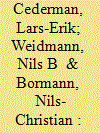

|
|
|
|
|
| Summary/Abstract |
Does economic inequality cause civil war? Deviating from individualist measures of inequality such as the Gini coefficient, recent studies have found a statistical link between group-level inequalities and conflict onset. Yet, this connection remains controversial, not least because of the difficulties associated with conceptualizing and measuring group-level differences in development. In an effort to overcome weaknesses afflicting specific methods of measurement, we introduce a new composite indicator that exploits the strengths of three sources of data. The first step of our method combines geocoded data from the G-Econ project with night lights emissions data from satellites. In a second step, we bring together the combined spatial values with survey estimates in order to arrive at an improved measure of group-level inequality that is both more accurate and more robust than any one of the component measures. We evaluate the effect of the combined indicator and its components on the onset of civil violence. As expected, the combined index yields stronger results as more information becomes available, thus confirming the initial hypothesis that horizontal economic inequality does drive conflict in the case of groups that are relatively poor compared to the country average. Furthermore, these findings appear to be considerably more robust than those relying on a single data source.
|
|
|
|
|
|
|
|
|
|
|
|
|
|
|
|
| 14 |
ID:
160327


|
|
|
|
|
| Summary/Abstract |
Political science takes pride in objective and methodologically rigorous research. This should be reflected in a clear and concise writing style that convinces readers by the content of the research, not by the language used to report about it. This article demonstrates that this is true but only to a limited extent. It shows that—similar to recent findings from natural-sciences research—the frequency of positive words that political scientists use to describe their research has increased markedly in recent decades. At the same time, however, the magnitude of this increase is much less pronounced. The article discusses and analyzes potential explanations for this trend. We suspect that it can be attributed at least partly to changing norms in the discipline, in which research framed in a positive way is more likely to be published.
|
|
|
|
|
|
|
|
|
|
|
|
|
|
|
|
| 15 |
ID:
152294
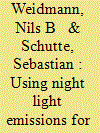

|
|
|
|
|
| Summary/Abstract |
Nighttime illumination can serve as a proxy for economic variables in particular in developing countries, where data are often not available or of poor quality. Existing research has demonstrated this for coarse levels of analytical resolution, such as countries, administrative units or large grid cells. In this article, we conduct the first fine-grained analysis of night lights and wealth in developing countries. The use of large-scale, geo-referenced data from the Demographic and Health Surveys allows us to cover 39 less developed, mostly non-democratic countries with a total sample of more than 34,000 observations at the level of villages or neighborhoods. We show that light emissions are highly accurate predictors of economic wealth estimates even with simple statistical models, both when predicting new locations in a known country and when generating predictions for previously unobserved countries.
|
|
|
|
|
|
|
|
|
|
|
|
|
|
|
|
| 16 |
ID:
119639
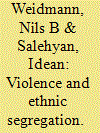

|
|
|
|
|
| Publication |
2013.
|
| Summary/Abstract |
The implementation of the United States military surge in Iraq coincided with a significant reduction in ethnic violence. Two explanations have been proposed for this result: The first is that the troop surge worked by increasing counterinsurgent capacity, whereas the second argument is that ethnic unmixing and the establishment of relatively homogenous enclaves were responsible for declining violence in Baghdad through reducing contact. We address this question using an agent-based model that is built on GIS-coded data on violence and ethnic composition in Baghdad. While we cannot fully resolve the debate about the effectiveness of the surge, our model shows that patterns of violence and segregation in Baghdad are consistent with a simple mechanism of ethnically motivated attacks and subsequent migration. Our modeling exercise also informs current debates about the effectiveness of counterinsurgency operations. We implement a simple policing mechanism in our model and show that even small levels of policing can dramatically mitigate subsequent levels of violence. However, our results also show that the timing of these efforts is crucial; early responses to ethnic violence are highly effective, but quickly lose impact as their implementation is delayed.
|
|
|
|
|
|
|
|
|
|
|
|
|
|
|
|
| 17 |
ID:
087274


|
|
|
|
|
| Publication |
2009.
|
| Summary/Abstract |
In the recent years, the field of conflict research has produced new findings on the relation between conflict and geography. In doing so, new data sets have been created with the help of GIS software. These data sets include variables relevant for the study of conflict with a spatial component. However, the use of geographic data requires specialized software and substantial training and therefore involves high entry costs for researchers and practitioners. This paper introduces the WarViews project whose aim is to create an easy-to-use front end for the exploration of GIS data on conflict. It takes advantage of the recent proliferation of Internet-based geographic software and makes geographic data on conflict available for these tools. With WarViews, geographic data on conflict can be accessed, browsed, and time-animated in a few mouse clicks, using only standard software. As a result, a wider audience can take advantage of the valuable data contained in these databases, for example, as supplementary data for conflict case studies or for classroom demonstrations. We present two versions of WarViews. The static version runs in a web browser and allows the user to switch between different data sets. The dynamic version is based on Google Earth and can time-animate geographic data such that the development over time can be monitored. The WarViews website can be freely accessed at .
|
|
|
|
|
|
|
|
|
|
|
|
|
|
|
|
|
|
|
|
|